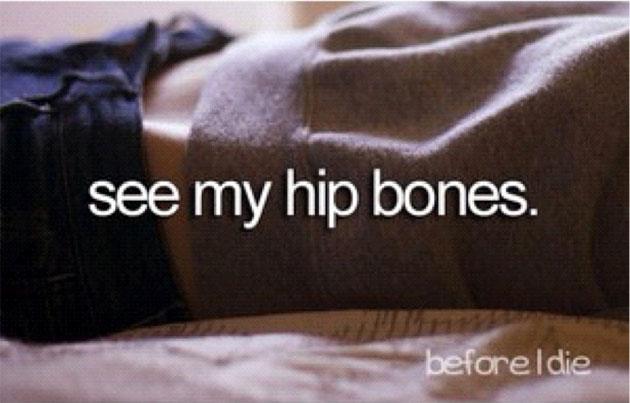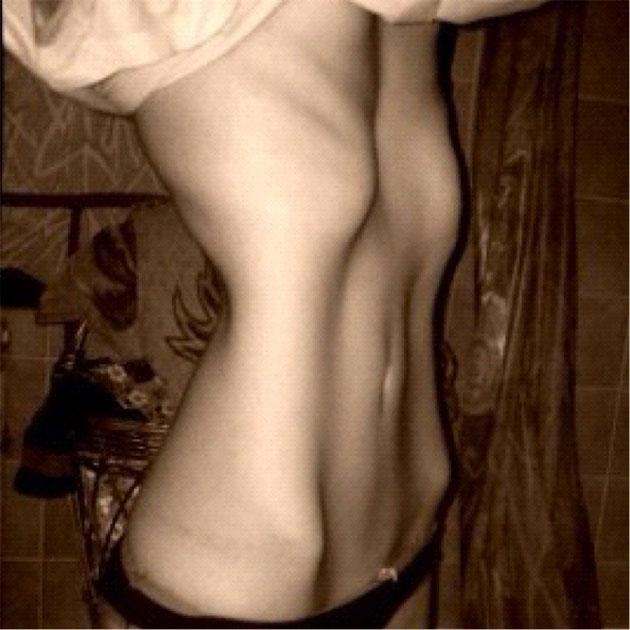
Thinspo and pro-ana communities are no recent revelation, with sites that cater to the subculture having existed almost as long as the Internet itself. But here and now, with technology and The Internet being what they are (bigger than Jesus, augmenting exponentially by the second) thinspo and pro-ana propagations are more rampant than ever. Newer virtual platforms have skyrocketed their prevalence and act ominously as fucking brilliant landscapes for having and maintaining an eating disorder.
For anyone unwise, pro-ana worlds are these kind of perturbing things that allow people with eating disorders to just have eating disorders to the best of their ability. If eating disorders were in an impenetrable wrought-iron cage (societal disapproval) then pro-ana communities are the miraculous freeing agent when anorexics and bulimics are screaming “JUST LET ME LIVE.” Lols aside, pro-ana spaces are a liberal and unashamed means to these mental illnesses flourishing.
In pro-ana spaces, eating disorders are framed not as mental illnesses but, because of their highly regimented nature, accomplishments that feed into a ‘lifestyle choice’. Thinspo material plays a huge role. Mostly comprising meme-style visuals, images of emaciated girls alongside short motivational quotes to inspire behaviours that reflect anorexia (ana) or bulimia (mia) are most common.
Also common are personal diaries that illustrate extreme calorie-counting, or self-reprimanding admissions of diet ruin or bingeing. Abbreviations like SW, CW, GW and UGW are typical vernacular (starting, current, goal and ultimate goal weight) and the air is thick with hyper-obsessiveness. Users know the overarching principles of pro-ana pertain to being supportive and non-judgmental. It’s irrefutably insular. It’s live to be thin or GTFO.

Before Tumblr imposed a ban to curb the phenomenon in February 2012 (Pinterest followed suit soon after) it was the ultimate space for glorifying eating disorders. When I think about Tumblr, I feel so fashion I could die. Of course, there’s much more to it than that (90s pop culture references, 90s fashion revival, candy coloured hair, septum piercings, fashion inspiration, unicorns, fashion styling, fashion icons) including a troupe of users who believe that nothing tastes as good as skinny feels – the famous words of one Kate Moss, unrivalled poster child for this business – but they’re dwindling.
Well, dwindling from Tumblr, but relocating elsewhere. Whether in a bid to dodge potential liabilities or reflecting genuine concern for users, Tumblr prohibited any content in support of self-harm in 2012, particularly pro-ana ideologies. Promptly, users jumped ship to another richly visual medium: Instagram.
It is this visual aspect, albeit repackaged, together with factors of ease and mobility that yields such reactionary camaraderie amongst sufferers. Too, the innately ‘creative’ nature of the app means users engage with what might even be described as a quasi-art form, applying filters and edits that glamorise a life-threatening illness. We could call it dying for art’s sake if that wasn’t completely snide and insensitive.

Image via instagram/ana_rexia
Instagram lends itself to the success of the subculture because it affords sufferers quick, effortless feedback. Just as with ordinary Instagrammers, Thinstagrammers measure their worth and influence numerically. A swift double-tap gives a like, and beyond 11 likes, you’re clocking up numbers. Just as my ego expands incrementally when likes for my substandard home cooking begin to roll in (pretty dangerous), likes in response to thinspo posts normalise a mental illness (actually legit dangerous) and users feel validated.
Adding to the danger is the lax policing enforced by Instagram. The measures can be summed up quickly because they are largely useless:
1) A pop-up disclaimer for #ana and #mia exists.
2) Along with that, users are linked to the American National Eating Disorders website.
3) Tagging #thin, #thinspiration and #thinspo are forbidden.
Thinstagrammers cackle triumphantly in the face of these censorship attempts. They go ha! And then they simply tweak hashtags to read things like #thynspo, #thinspooo and #th1nspo – meaning the subculture is easily sustained, completely bypassing negative or sneering outside opinions and strengthening an overall sense of community.
Between 2006 and 2008 pro-ana sites increased by 470% and here in Australia there are no laws that pro-ana sites breach. Consequently, it’s arguable that any attempt to blacklist these sites is an unjustified curtailment on freedom of expression. Powered by a sense of non-hierarchical ownership, more traditional top-down, centralised control from above is absent. Instagram provides an alternate reality for the eating disordered; a reality far-flung from any conventional IRL realm where championing an eating disorder would be unforgivable.

Image via statigr.am/never_goodenough
So it is this peripherally governed, participatory culture that solidifies the thinspo/pro-ana community. And it’s actually a double-edged sword. Platforms like Instagram are at once a place for enabling harm and preventing it. Uniting sufferers so that they may sustain their mental illnesses, yes it does. But it is also something of a safety.
Associate Professor of Digital Humanities, Antonio Casilli, last year proposed that “censorship encourages the formation of densely-knitted, almost impenetrable ana-mia [anorexic-bulimic] cliques.” So while the current Instagram regulations have done little to curb the phenomenon, its reign might alleviate user’s alienation from society and interestingly, makes them more accessible for health professionals.
That’s not to say pro-ana realities are positively charged, with damaging implications blatantly outweighing those positive. However, it’s worth examining that from the perspective of users, the intention is not to recruit or seduce unassuming young girls into becoming anorexic. Disclaimers adopted by some users more practically imply that they are catering to an already existing anorexic community. For example, “…if you are looking to become anorexic or bulimic by being here then please leave” or “This account contains dangerous information. If you are not part of the pro-ana community, this is not the place for you”.
These disclaimers reveal an insular target market – but do not deny the fact that the eating disordered carefully ingest material on these platforms. So while they’re not ingesting mountains of food (sans purging), a 2006 pilot study of people with eating disorders revealed that what they do consume is pro-ana material in high proportions, with 69% of sufferers admitting to using weight loss techniques learned from pro-ana sites. The propensity for harm is invariably hard to ignore.

Image via instagram/ana_rexia
Without actual governmental laws in place that forbid pro-ana communities and thinspo material, the subculture seems fairly impervious to any wide reaching intervention. Here, we might like to point long and accusatory fingers at the fashion industry and ‘society’ (we can blame those guys for anything) for constructing unrealistic ideas of beauty. But unfortunately, practically, realistically, that blame game seems tired and its roots too firmly planted.
Flimsy regulations implemented by social media platforms do not sufficiently protect users, with the fear of liability seemingly the primary motive. So while it’s fantastic that laterally governed, user-generated content gives way to freedom of speech, the vital flaw with such digital configurations is that they forego the authoritative figureheads that are necessary to administer an adequate duty of care. 2008 saw the French Parliament table a bill making it illegal to engage with pro-ana philosophies. The law would impose a two year sentence plus a fine of 30,000 euros (around AUD$38,350) for “incitement to excessive thinness by publicising of any kind”. Pretty heavy innit?
I’m no expert on changing a nation but I imagine taking some cues from the French might be a fine place to start.
The Butterfly Foundation‘s National Support Line, 1800 ED HOPE, provides confidential support for Australians suffering eating disorders and negative body image.
Written by Mel Kenny who is interested in all types of virtual communitites, mostly Line Play. She (rarely) tweets here.



